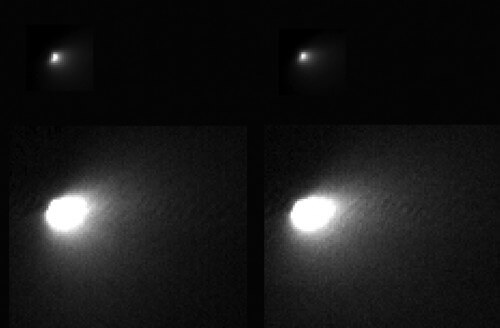The MRO spacecraft (Mars Reconnaissance Orbiter) photographed the comet Siding Spring in high resolution from a distance of 140 thousand km. Even at this resolution, the width of the kernel is only 3 pixels - only half a kilometer.

The High-Resolution Science Imaging Experiment (HiRISE) camera on board the Mars Reconnaissance Orbiter (MRO) imaged comet C/2013 A1 Siding Spring from the spacecraft's orbit around Mars as the visitor sped past Mars on Sunday, October 19 yielding much information about our findings.
The images show in the best resolution ever used to photograph a fresh comet coming from the Oort cloud at the extreme edge of the solar system. Other spacecraft have approached or closely studied comets with shorter orbits. The passage of this comet near Mars provided spacecraft orbiting or on the surface of the planet Mars an opportunity to study it closely.
The sharpest image of the comet nucleus was taken by HiRISE from a distance of about 138 thousand km. Therefore its scale is about 140 meters per pixel.
Scientists who relied on telescopic observations from Earth built a model of the size of the comet's nucleus before the passage and from it it appears that it is about a kilometer in diameter, however the best HiRISE images showed that the diameter of the brightest part is 2-3 pixels and according to the estimate it is the comet's nucleus. This means that it is about half the size of the early estimate.
The image composed of two versions of two of the best photographs of the comet by HiRISE, in the upper part the images from dynamic range, show the nucleus and the bright halo near the nucleus. At the bottom of the image you see two clarified versions of the outer halo, in which the inner area is saturated. The pictures on the left and right were taken nine minutes apart.
The closest images were made possible by an MRO pointing and stability system by engineers at Lockheed Martin in Denver, based on calculations of the comet's position by engineers at NASA's Jet Propulsion Laboratory in Pasadena, California.
HiRISE took three images 12 days before the comet's approach, when the comet was barely visible above the "background noise" of the images. These first images indicate that the comet was not exactly in the predicted position. A new angle of view of the comet was used to update the location and timing of the closest approach. Without this update, the comet might have been out of HiRISE's frame at dawn.

4 תגובות
skeptic
If you refer to the quality of your response, it has an advantage. No need to look for a tombstone.
Although not of the size they observed, there were some smaller ones even before this, apparently these are the limitations of the observation means that exist
Today in humans when it is at a distance,
But still impressive to get the impression of what it is think about
Something the size of a mountain 500 meters high moves at a speed relative to Mars of 56 km per second,
If it came directly to the earth it would take about 2 seconds to go through the entire atmosphere,
Or another description of a mountain about 500 meters high running the length of Israel from Eilat to Metula in about 8 seconds,
You shouldn't be near a place where something like this hurts, it wouldn't be nice,
If the diameter is only half - nineteen km instead of one km, then the size of the comet is one eighth of its volume/mass and not half.
Just math.
A little disappointing.
NASA has been making bombastic announcements several times and disappointing millions of astronomy enthusiasts
Good night
Yehuda